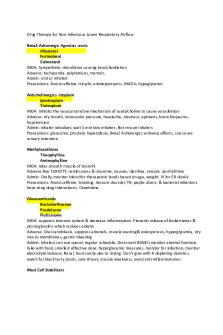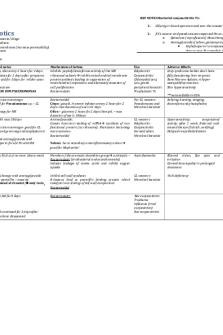Drugs in solution PDF

| Title | Drugs in solution |
|---|---|
| Course | Basic Pharmaceutical Sciences |
| Institution | University of Sydney |
| Pages | 10 |
| File Size | 513.5 KB |
| File Type | |
| Total Downloads | 831 |
| Total Views | 1,016 |
Summary
Name (SID): .................................................................Name (SID): .................................................................Name (SID): .................................................................Date: ......................Tutor: .....................................
Description
PHAR1812 Basic Pharmaceutical Sciences 2020
Name (SID): ................................................................. Name (SID): ................................................................. Name (SID): .................................................................
Date: ...................... Tutor:…………………………………………… Tutor:……………………………………………
Drugs In Solution (DIS) Workshop This workshop relates to the Drugs in Solution lectures and students should revise their lecture notes and bring them to the workshop. The purpose of the workshop is to assist students in meeting a number of the learning outcomes for this topic – the details are included on the following page. The completed report must be submitted to Dropbox by midnight on the day of your workshop in week 10. Revised report with marks and feedback will be provided in week 12.
The data for Questions 1,2 and 4-6 is provided on Canvas.
This workshop is designed to help you achieve the following learning outcomes: 4, 8, 9, 10, 11, 13, 14, 18, 19, 20 and 21.
Drugs in Solution workshop
1
PHAR1812 Basic Pharmaceutical Sciences 2020
Exercise 1 The following calculations relate to G and G°. The biochemical reaction FDP
G-3-P + DHAP
was mentioned in lectures. The details of the compounds taking part in the reaction are not important, but G° for this reaction is 26.1 kJ/mol at body temperature (37°C). A solution is prepared at body temperature containing 10^-4 M of both G-3-P and DHAP, and you need to calculate the minimum concentration of FDP that must be present before the reaction will proceed spontaneously in the forward direction. Which equation will you use to carry out this calculation? Why? (0.5 marks)
Carry out the calculation. (1 mark)
Drugs in Solution workshop
2
PHAR1812 Basic Pharmaceutical Sciences 2020
Exercise 2 Sodium cholate is a bile salt that plays an important part in the dissolution of cholesterol in the body. Sodium cholate can exist as either a monomer or a dimer in aqueous solution: 2(monomer) i.
dimer
At equilibrium at ………°C, the concentration of the monomer is ……………… M and the concentration of the dimer is ……………… M. Calculate the standard free energy change for the dimerisation process at T°C.
Which equation will you use to carry out this calculation? Why? (0.5 marks) ∆G° = ∆H° - T∆S° = -RTlnKEQ
Carry out the calculation. (1 mark)
ii.
The concentration of the monomer is held constant, and the concentration of the dimer is reduced to one-tenth of its original value. Calculate the value of G, and predict in which direction the reaction will proceed.
Which equation will you use to carry out this calculation? Why? (0.5 marks)
Carry out the calculation. (1 mark)
Drugs in Solution workshop
3
PHAR1812 Basic Pharmaceutical Sciences 2020
Exercise 3 Chlorocresol is a common preservative in a number of pharmaceutical preparations. Martindale’s Extra Pharmacopoeia lists its solubilities as 1g in 260mL of water and 1g in 50mL of boiling water. It can be assumed that the temperature of “water” is 25°C, and of “boiling water” is 100°C, and the molecular weight of chlorocresol is 143. 3.87/143 i
Calculate the standard enthalpy change for the dissolution of chlorocresol.
Which equation will you use to carry out this calculation and why? (0.5 marks)
0.02689 Carry out the calculation. (1 mark)
ii
Calculate the standard free energy change for this reaction at T = 25 °C.
Which equation will you use to carry out this calculation and why? (0.5 marks)
Carry out the calculation. (1 mark)
Drugs in Solution workshop
4
PHAR1812 Basic Pharmaceutical Sciences 2020
iii.
Calculate the standard entropy change for the dissolution of chlorocresol.
Which equation will you use to carry out this calculation and why? (0.5 marks)
∆G° = ∆H° - T∆S°
Carry out the calculation. (1 mark)
iv
You prepare 40 mL of an eye drop solution which contains 100 mg chlorocresol. Will you need to heat the water above room temperature (25°C) in order to dissolve the chlorocresol? Which equation will you use to carry out this calculation and why? (0.5 marks)
Carry out the calculation. (1.5 marks)
Drugs in Solution workshop
5
PHAR1812 Basic Pharmaceutical Sciences 2020
Exercise 4 Some students believe that it is appropriate to use the molar solubility of an ionisable drug in the van’t Hoff isochore. This is incorrect however, as the van’t Hoff isochore requires equilibrium constants. It would be a good idea to refer to your lecture notes while doing these calculations, and to keep focusing on working out the equilibrium constant for each reaction. i.
The solubility of a nonionisable drug (MW = 250 ) in water is 2.45 mg/mL at T1 = 35C. If the enthalpy of solution is 25.5 kJ/mol, calculate its solubility in M at T2 = 50C. (1 mark)
ii.
If the solubility of AgCl is 1.5 x 10-4 g/100mL at T = 20 °C, and the enthalpy of solution is 62.7 kJ/mol, calculate the solubility of AgCl at T = 45C. (1 mark)
Drugs in Solution workshop
6
PHAR1812 Basic Pharmaceutical Sciences 2020
Exercise 5 Sheets with the structures of Drugs A-E and their pKa values will be available from your tutor.
i
ii
Using the structures of the drugs and their pKa values, indicate whether each of the following drugs would be largely (ie more than 50%) in the ionised or unionised form at the pH indicated. (1 mark) a.
Drug ….. (………………) at pH …….
b.
Drug ….. (………………) at pH …….
c.
Drug ….. (………………) at pH …….
d.
Drug ….. (………………) at pH …….
Calculate the percentage ionised in each of the following cases. (2 marks) a.
Drug ….. (………………) at pH …….
b.
Drug ….. (………………) at pH …….
Drugs in Solution workshop
7
PHAR1812 Basic Pharmaceutical Sciences 2020
c.
Drug ….. (………………) at pH …….
Exercise 6 Calculate the percentage of the drug which would be in the aqueous phase after the following extractions. a.
Drug ….. (………………) in 50 mL aqueous solution at pH ……. extracted with 50 mL ether, given that P = 79 for the unionised form.
What information do you have about partition coefficients? Is it the true or apparent partition coefficient? How do you know? (0.5 marks)
At pH …………., do you need to use the true or apparent partition coefficient to calculate the percentage in the aqueous phase? (0.5 marks)
Drugs in Solution workshop
8
PHAR1812 Basic Pharmaceutical Sciences 2020
Carry out the relevant calculation. (1 mark)
b.
Drug …… (……………………..) in 30 mL aqueous solution at pH 12 extracted with 50 mL chloroform, given that P = 860 for the unionised form.
What information do you have about partition coefficients? Is it the true or apparent partition coefficient? How do you know? (0.5 marks)
At pH …….., do you need to use the true or apparent partition coefficient to calculate the percentage in the aqueous phase? (0.5 marks)
Drugs in Solution workshop
9
PHAR1812 Basic Pharmaceutical Sciences 2020
Carry out the relevant calculation. (1 mark)
Mark (out of 20):__________________
Date:___________________
Signature:________________________
Feedback
Dogs are said to have the most powerful senses . from being able to Or even sense human emotions
However, it seems that all dogs have something in common which Dogs are creatures with https://www.rover.com/blog/can-dogs-see-color-cool-facts-dog-eyesight/
Drugs in Solution workshop
10...
Similar Free PDFs

Drugs in solution
- 10 Pages

Drugs In Solution Draft Notes
- 42 Pages

Drugs USED IN Parkinson Disease
- 10 Pages

Herpes drugs, anti cancer drugs
- 6 Pages

WAR ON DRUGS IN THE PHILIPPINES
- 5 Pages

Hemostasis drugs
- 5 Pages

Psychotomimetic drugs
- 7 Pages

Controlled Drugs
- 25 Pages

Pp2soln - solution in c++
- 3 Pages

Respirotory Drugs
- 3 Pages

Dopaminergic Drugs
- 2 Pages

Drugs-immmunity
- 19 Pages

solution problems in Exam
- 6 Pages
Popular Institutions
- Tinajero National High School - Annex
- Politeknik Caltex Riau
- Yokohama City University
- SGT University
- University of Al-Qadisiyah
- Divine Word College of Vigan
- Techniek College Rotterdam
- Universidade de Santiago
- Universiti Teknologi MARA Cawangan Johor Kampus Pasir Gudang
- Poltekkes Kemenkes Yogyakarta
- Baguio City National High School
- Colegio san marcos
- preparatoria uno
- Centro de Bachillerato Tecnológico Industrial y de Servicios No. 107
- Dalian Maritime University
- Quang Trung Secondary School
- Colegio Tecnológico en Informática
- Corporación Regional de Educación Superior
- Grupo CEDVA
- Dar Al Uloom University
- Centro de Estudios Preuniversitarios de la Universidad Nacional de Ingeniería
- 上智大学
- Aakash International School, Nuna Majara
- San Felipe Neri Catholic School
- Kang Chiao International School - New Taipei City
- Misamis Occidental National High School
- Institución Educativa Escuela Normal Juan Ladrilleros
- Kolehiyo ng Pantukan
- Batanes State College
- Instituto Continental
- Sekolah Menengah Kejuruan Kesehatan Kaltara (Tarakan)
- Colegio de La Inmaculada Concepcion - Cebu


